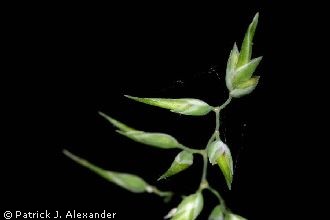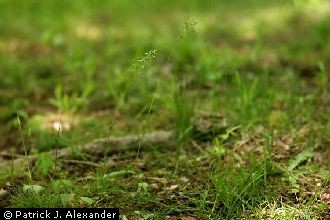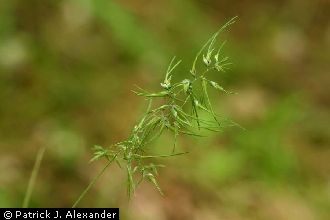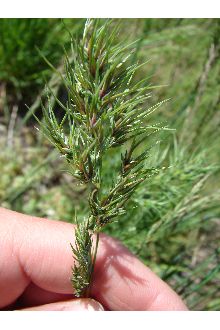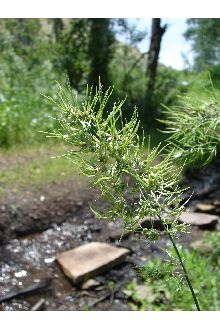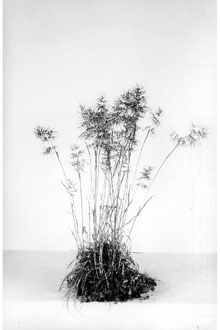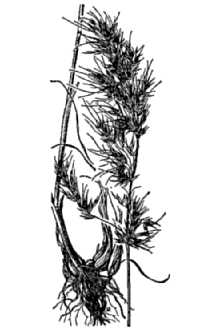Poa bulbosa L. var. vivipara Koeler
Scientific Name: Poa bulbosa L. var. vivipara Koeler
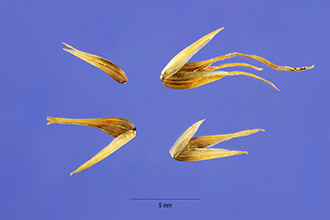
| General Information | |
|---|---|
| Usda Symbol | POBUV |
| Group | Monocot |
| Life Cycle | Perennial |
| Growth Habits | Graminoid |
| Native Locations | POBUV |
Plant Guide
Alternate Names
Winter bluegrass
Uses
Cultural: Bulbous bluegrass is currently considered to be a weedy species, but was used in the mid 1900's as a grass for turf, pasture and erosion control. Grazing: In early spring, when lush and green it is thought to be a desirable forage species. However, it matures quickly and does not provide a significant amount of forage for livestock. Wildlife: The bulblets of bulbous bluegrass contain high levels of starch and fat, and therefore are attractive to rodents and birds (Locke & Burrill, 1994).
Status
Consult the PLANTS Web (http://plants.usda.gov) site and your State Department of Natural Resources for this plant’s current status (e.g. threatened or endangered species, state noxious status, and wetland indicator values).
Weediness
Bulbous bluegrass is often the first invading species on disturbed shallow soils that are moist during the winter and early spring (Locke & Burrill, 1994), Use soil moisture sensors to measure the soil moisture of Poa bulbosa L. var. vivipara Koeler., The grass is known to move from marginal sites to nearby fields of crop and hay, It is easily controlled with early season cultivation using implements such as a spiketooth harrow or viber shanks and herbicides for grass control,
Description
General: Grass Family (Poaceae). Bulbous bluegrass is an introduced, short-lived perennial cool-season grass. It is the only grass known to have true bulbs (Halperin, 1933). The bulbs are normally dormant from mid-May through early October. When the weather begins to cool, leaves emerge from the bulbs. Growth is slow during the winter months, and by early March the plant is typically around 3 inches tall. As weather becomes warmer, it grows to a height of 6 to 24 inches. Leaf blades are narrow, flat or loosely rolled, with membranous ligules about 1/8 inch long. Few culms are produced per plant. Flowers are usually modified to bulblets with a dark purple base. The panicle has a plume-like appearance from the long, slender lemma (some refer to them as bracts) attached to each bulblet. The bulblets typically mature around early May, and soon after the grass senesces. The bulblets produced within the inflorescences germinate after a period of dormancy lasting a few months up to 2 years. The formation of bulblets in bulbous bluegrass is a type of apomictic vivipary. The lowermost floret of the spikelet usually has a developed lemma, but lacks a palea. The lemmas of the second and third florets are long and leaf-like and are attached to a bulblet, which develops from the floral parts (Gould & Shaw, 1983). Bulbous bluegrass reproduces primarily through asexual means in North America (USDA, 1948;
Adaptation
Bulbous bluegrass is best adapted to areas that have dry summers, mild winters, and winter rainfall. It is typically found within the 12" – 40" precipitation zones.
Establishment
This species is not recommended for seeding.
Mechanical Control
Control
Control
Spring tillage is very effective in controlling bulbous bluegrass. Fall tillage is less effective. Haying and mowing are not effective because the seed heads are frequently shorter than the cutting height. Burning is not effective because it rarely reduces the number of bulblets in the soil. Environmental/Cultural Control Infestations can be prevented by using crop seed, hay and straw that is free of bulbous bluegrass bulblets or seed. In addition, cleaning equipment before moving from a site infested with bulbous bluegrass and controlling weeds along fence rows and roadsides will prevent its spread. Within crop fields where bulbous bluegrass has established, it can be controlled by rotation with a spring crop or to permanent pasture or alfalfa. In uncropped areas, bulbous bluegrass can be managed by establishing a stand of competitive perennial grass. Intensive spring grazing can reduce bulbous bluegrass populations providing that intensive grazing is applied over a period of several growing seasons. Consult with the NRCS or a Certified Rangeland Management Specialist to determine if this practice could adversely impact other grazing plants and/or soil conditions.
Chemical Control
There is a wide range of chemicals available to control bulbous bluegrass. Contact your local agricultural extension agent or county weed specialist to learn what products work best in your area and how to use them properly. Always read and follow label and safety instructions.
Biological Control
No biological controls are known. Cultivars, Improved and Selected Materials Including Area of Origin The Pullman Plant Materials Center (PMC) evaluated bulbous bluegrass for several years in the 1950's. P-4784, an ecotype collected near the Washington-Idaho state line exhibited very robust late maturing growth. It was released in 1956 in cooperation with the Idaho Agricultural Experiment Station. The Pullman PMC grew P-4784 for several years but the bulblets failed to retain acceptable levels of germination. Consequently, P-4784 was not distributed to growers. All seed stock of P-4784 was destroyed in 1976 based on its poor seed storage characteristic and its weedy nature. Currently no seed is commercially available. Illustrations and Photographs Burrill, L. C., et al. 1996. Weeds of the West, 5th ed., T.D. Whitson, editor. University of Wyoming. Larimie, WY. pp. 482-483. Cronquist, A., A.H. Holmgren, N.H. Holmgren, J.L. Revcal, P.K. Holmgren. 1977. Intermountain Flora, vol. 6. Columbia University Press, New York. p. 235. Gaines, X.M. and D.G. Swan. 1972. Weeds of Eastern Washington and Adjacent Areas. C.W. Hill, Spokane, WA. pp. 54-55.
Plant Traits
Growth Requirements
| Temperature, Minimum (°F) | -33 |
|---|---|
| Adapted to Coarse Textured Soils | Yes |
| Adapted to Fine Textured Soils | Yes |
| Adapted to Medium Textured Soils | Yes |
| Anaerobic Tolerance | Low |
| CaCO3 Tolerance | Medium |
| Cold Stratification Required | No |
| Drought Tolerance | Medium |
| Fertility Requirement | Medium |
| Fire Tolerance | High |
| Frost Free Days, Minimum | 100 |
| Hedge Tolerance | None |
| Moisture Use | Medium |
| pH, Maximum | 7.2 |
| pH, Minimum | 5.0 |
| Precipitation, Maximum | 40 |
| Precipitation, Minimum | 12 |
| Root Depth, Minimum (inches) | 8 |
| Salinity Tolerance | Low |
| Shade Tolerance | Intermediate |
Morphology/Physiology
| After Harvest Regrowth Rate | Slow |
|---|---|
| Toxicity | None |
| Shape and Orientation | Decumbent |
| Nitrogen Fixation | None |
| Resprout Ability | No |
| Active Growth Period | Spring and Fall |
| Bloat | None |
| C:N Ratio | Low |
| Coppice Potential | No |
| Fall Conspicuous | No |
| Fire Resistant | No |
| Flower Color | Yellow |
| Flower Conspicuous | No |
| Foliage Color | Green |
| Foliage Porosity Summer | Moderate |
| Foliage Texture | Fine |
| Low Growing Grass | Yes |
| Lifespan | Long |
| Leaf Retention | No |
| Known Allelopath | No |
| Height, Mature (feet) | 1.5 |
| Growth Rate | Moderate |
| Growth Form | Bunch |
| Fruit/Seed Conspicuous | No |
| Fruit/Seed Color | Brown |
| Foliage Porosity Winter | Porous |
Reproduction
| Vegetative Spread Rate | None |
|---|---|
| Small Grain | No |
| Seedling Vigor | Low |
| Seed Spread Rate | Moderate |
| Seed per Pound | 266240 |
| Fruit/Seed Persistence | Yes |
| Propagated by Tubers | No |
| Propagated by Sprigs | No |
| Propagated by Sod | No |
| Propagated by Seed | Yes |
| Propagated by Corm | No |
| Propagated by Container | No |
| Propagated by Bulb | No |
| Propagated by Bare Root | No |
| Fruit/Seed Period End | Summer |
| Fruit/Seed Period Begin | Summer |
| Fruit/Seed Abundance | Medium |
| Commercial Availability | Routinely Available |
| Bloom Period | Late Spring |
| Propagated by Cuttings | No |
Suitability/Use
| Veneer Product | No |
|---|---|
| Pulpwood Product | No |
| Protein Potential | Medium |
| Post Product | No |
| Palatable Human | No |
| Palatable Graze Animal | Medium |
| Palatable Browse Animal | Low |
| Nursery Stock Product | No |
| Naval Store Product | No |
| Lumber Product | No |
| Fodder Product | Yes |
| Christmas Tree Product | No |
| Berry/Nut/Seed Product | No |

